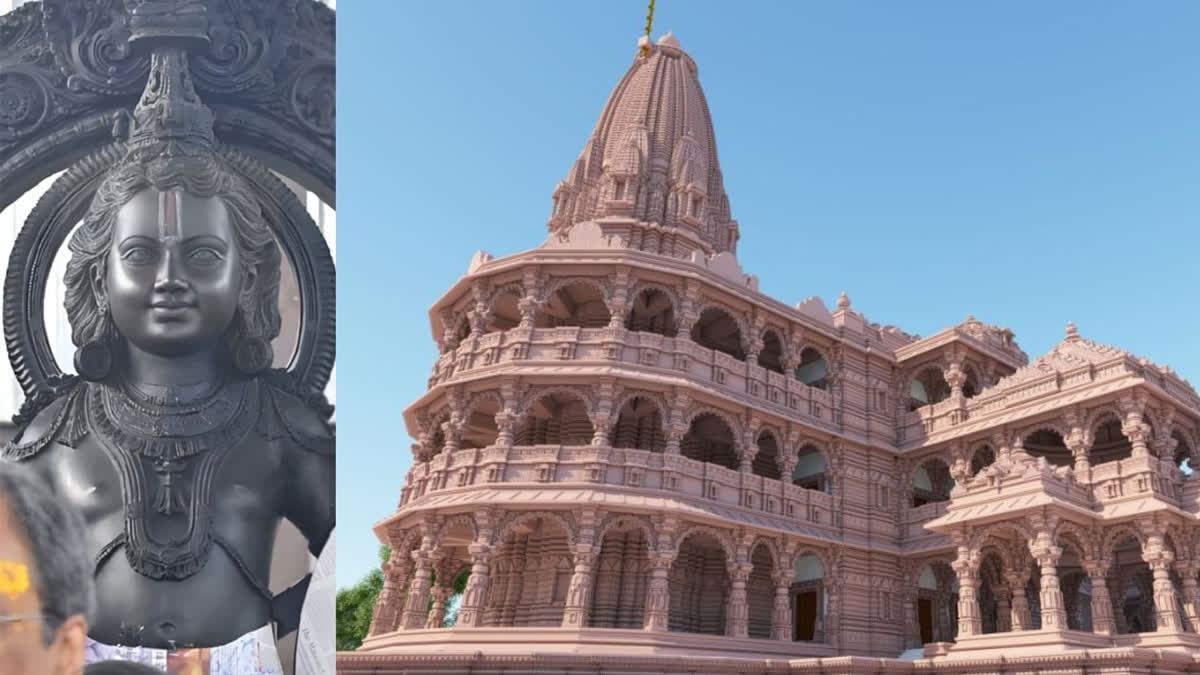Hyderabad: The whole world is eagerly awaiting the historic consecration of the newly-built Ram Temple in Ayodhya, Uttar Pradesh on Monday. Tumultuous events have taken place all through history leading up to the demolition of the disputed structure and the construction of a grand temple in the birthplace of Prince Ram.
It was in 1526 that Babar invaded India and defeated Ibrahim Lodi in the first battle of Panipat which marked the beginning of the Mughal empire. One of his generals began the conquest of northeast India when he built a huge mosque in Ayodhya in 1528 and named it Babri-Masjid in a tribute to Babar. It also had a provision for Hindus to worship outside the mosque but inside its compound.
Here is the chronology of events that will culminate in the inauguration of Ayodhya Ram Temple in the presence of Prime Minister Narendra Modi on Monday (January 22, 2024).
1528: The controversial construction of a mosque at the disputed site was ordered by Mughal Emperor Babur's commander Mir Baqi. The Hindu community claimed that this place was the birthplace of Lord Rama and that there was an ancient temple at this site. The Hindus asserted that the spot beneath one of the domes of the mosque housed Lord Rama's birthplace.
1529: Babri Mosque constructed by Mir Baqi.
1885: Legal dispute begins. Mahant Raghubir Das files the first suit in the matter, seeking to build a temple on land adjoining the mosque. The Faizabad District Magistrate (DM) refuses permission. Next, Mahant Raghubir Das files a title suit in Faizabad Court against the Secretary of State for India, seeking permission to build a temple on the chabutra (courtyard) of the Babri mosque. Faizabad Court rejects his plea.
1949:On the night of December 22nd, a Ram idol appears inside the mosque. Hindus see the appearance of the Idol as a divine revelation, however many argue that the idol was smuggled inside at night. Hindus start offering prayers. The Government declares the site a “contested area” and locks the entrance.
1950: Hindu sides file suits. Two suits are filed in Faizabad Court by Gopal SimlaViharad and Paramhansa Ramachandra Das, seeking permission to conduct Hindu pujas to Ram Lalla. The Court granted the parties permission to conduct pujas. The Court orders the inner courtyard gates to remain locked.
1959: Third Hindu suit filed. Nirmohi Akhara files a third suit, seeking possession of the land.
1961: Muslim suit filed. UP Sunni Wakf Board files a suit seeking possession of Babri Mosque site. They also demand the removal of Ram idols from Babri Masjid.
1984: Ram Janmbhoomi Movement commences. Vishwa Hindu Parishad (VHP) constitutes a group to start the Ram Janmbhoomi Movement. BJP leader LK Advani is made the leader of the campaign.
1986 (February 1): Inner Gate of Babri Mosque opened. A third party lawyer UC Pandey appeals to the Faizabad Sessions Court for the gates to be unlocked on the ground that the Faizabad district administration, and not court, had ordered its closure.
1989 (November 9): Shilanayas performed. The then PM Rajiv Gandhi allows the VHP to perform Shilanayas (laying of foundation stone) near the disputed area.
1989: All title suits shifted to Allahabad High Court. Another suit in the name of Ram Lalla Virajman was filed in the High Court, naming the parties in the Nirmohi Akhara (1959) and Sunni Waqf Board (1961) suits as defendants.
1990 (September 25): LK Advani launches Rath Yatra from Somnath (Gujarat) to Ayodhya (UP) to garner support for the temple movement. Communal riots break out.
1992 (December 6): Babri Masjid demolished by a violent mob of Karsevaks. The Karsevaks leave behind a makeshift temple in its place.
1992 (Dec 16): Liberhan Commission formed. Ten days after the mosque was demolished, the then PM forms a committee led by retired High Court Justice M. S. Liberhan, to look into circumstances leading to the demolition of the Babri Mosque and the communal riots. The Commission was originally mandated to submit its report within three months of its formation.
1993 (Jan 7): State acquires Ayodhya land. The then Narsimha Rao Government issues an ordinance acquiring 67.7 acres of land (site and adjoining areas). Later it was passed as a law – Acquisition of Certain Areas at Ayodhya Act, 1993 - to facilitate the acquisition of land by the Central government.
1993 (Apr 3):‘Acquisition of Certain Area at Ayodhya Act’ passed for acquisition of land by Centre in the disputed area. Various writ petitions, including one by Ismail Faruqui, filed in Allahabad HC challenging various aspects of the Act. The Supreme Court, exercising its jurisdiction under Article 139A, transferred the writ petitions, which were pending in the High Court.
1994: Ismail Faruqui Judgment. The SC by a majority of 3:2 upheld the constitutionality of Acquisition of Certain Areas at Ayodhya Act. The majority judgment by former CJI J.S. Verma reasoned that every religious immovable property is liable to be acquired. The SC adjudged that offering namaz at mosque was not integral to Islam unless that mosque had any particular significance in Islam. The judgment has been criticized for regarding the mosque as a non-essential place of worship.
